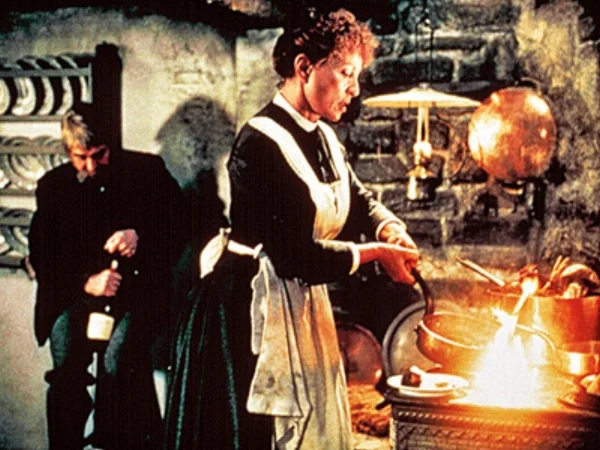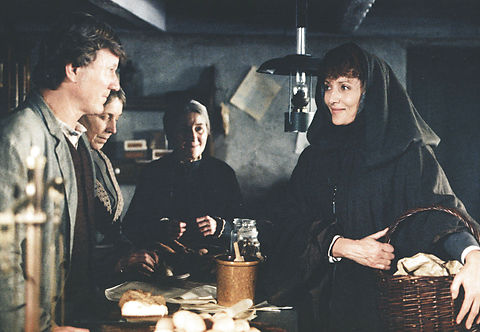Babettes Feast: Finding meaning in food
Stock Image
After hearing that Americans were interested in stories about food, Karen Blixen (pen name Isak Dinesen) wrote a short piece centered on the personal and spiritual transformation of a small and elderly congregation of pious Catholics after experiencing for the first time, the gastronomic delights of a “true French feast”.
Blixen’s story was originally published in 1958 and then turned into an Academy Award winning film, directed by Gabriel Axel in 1987. The film has since been renowned amongst food lovers for its sensual storyline and delectable cinematography.
In fact, viewers were left salivating to such an extent that in 1988 some 500 restaurants across America served dishes featured in the film consisting of limpid turtle soup laced with Madeira, blinis Demidoff with caviar, quails en sarcophagi (stuffed with foie gras and truffles in puff pastry cases), salad, exotic cheeses, tropical fruits and baba au rhum, all thoughtfully paired with rare and expensive Champagne and fine wines in order satisfy the appetite stirred by the film.
More than just a feast for the eyes, like the novella, the film explores issues of morality, earthly pleasure, fraternal love and abundance with a deep and thought provoking narrative that has been subject of numerous essays and has been interpreted from several frames of reference – sociocultural, psychoanalytic and especially religious. It is not the intention of this paper to dissect and analyse the complexity of the story, but to consider the symbolism food plays in adding context to the story line, the various roles of food in the film, how the feast functions as a code central to the meaning of the film and how the inclusion and focus on food led to the film’s success.
Plot
The movie begins in a small Protestant village in the remote Jutland peninsula, Denmark, led by a very rigid minister with extremely “puritan” beliefs. Sisters, Martin (Birgitte Federspiel) and Filippa (Bodil Kjer) are the minister’s daughters and have been raised to strictly adhere to the many rules which prevent them from indulging in any earthly pleasures including marriage.
After the minister dies, the sisters become responsible for leading the congregation. One day, Babette Hersant (Stephane Audran) comes to the village and knocks on the sister’s door. Babette is a Parisian gourmet Chef and was forced to flee France during the war of 1871 in which her husband and son were killed.
Cold and exhausted Babette is welcomed into the sisters home where she hands them a letter from their mutual friend (and Filippa’s former suitor) Achille Papin in which he implores them to provide Babette with refuge and employ her has their servant.
During the fourteen years that follow, Babette dutifully serves the sisters without complaint and during this time has a marked effect on the community. Then one day, she receives her first contact from France, a letter advising she has won 10,000 Franks in the French lottery.
Instead of using the money to fund her return to France, Babette requests permission to prepare a memorial dinner in honour of the minister’s one-hundredth birthday. Reluctantly the sisters agree. The townspeople are horrified by the sheer volume and array of exotic and colourful ingredients and are convinced by the sisters that Babette has assembled fare to that of a witches’ Sabbath. The invited guests make a secret pact that they will endure the dinner for Babette’s sake however are set on refusing to enjoy what she cooks and will not comment on what is served.
Of the twelve guests who attend the dinner, only one is not aware of the pact, General Lorens Lowenhielm, (Martina’s former suitor) and utilises every opportunity to openly marvel at the dishes served.
Despite their best intentions to cleanse their tongues of all taste, they quickly discover it is harder to resist then they had originally thought. By the final course, they cannot contain themselves and openly enjoy the feast.
Food
Throughout the film, food is featured in imagery, in language and as a central topic of the film. It depicts the time in which the story was set (a time of poverty), the religious and ethical beliefs of the community as well as their economic situation. Furthermore, food is used as a tool to emotionally engage and entice the viewer.
Religion, ethics and the representation of Christ
Food is used on numerous occasions to communicate the ethical beliefs held by the community. Before Babette arrived, a senior gentleman is offered a small portion of clear broth with just a taste of diced vegetables for substance. No bread. No meat. No accompaniments. No table settings. No company. It is clear that there is to be no joy in this meal and its purpose is to purely serve the function of keeping hunger at bay and to provide just enough sustenance until the next meal.
In the film’s second scene, a close up image of cod air drying in the wind on wooden racks functions at both the realistic and symbolic levels. The cod is a staple ingredient in the diet of the Danish poor (as dried fish is in other nations across the world) whilst also serving as a symbol of the presence of Christ – the symbol of fish is found throughout Christian art.
Upon witnessing the ingredients to be used for the feast being delivered to Babette’s kitchen, Martine has a nightmare in the form of a witches Sabbath. Flashbacks of Babette dressed in a cloak (her raincoat and hood), smiling wickedly over a boiling cauldron (a pot of simmering stock) as well as images of live animals and their subsequent carcasses. It leaves the audience with no question that Martina is worried about the evils that she believes she will be exposed to during the feast.
Axel goes to great lengths to illustrate Babette’s and the sisters Christ-like features and behaviours. The sisters represent Christ in their commitment to their father’s mission, spending all their time and income on sheltering the homeless (Babette), feeding the hungry, tending to the sick however despite their good deeds, they are unable to unite the remaining members of their congregation and provide them with practical advice and solutions to resolve their conflicts. Despite the sister’s strict adherence to the Word of their leader, Babette is portrayed as the community’s redeemer. This is illustrated by her sacrifice of any possibility of an affluent life through the symbolism reflected in her painstaking preparations of the centenary dinner which Axel captures in meticulous detail.
Early in the morning of the day of the feast, Babette begins slaughtering, disembowelling, dismembering, skinning, plucking, and slicing. In the background, a fire crackles furiously. A monstrous tortoise breathes eerily while moving its head slowly from side to side. A flayed calf’s head, ghastly white, lies in a bowl, like a corpse laid out in a casket. A barrow full of bloody innards and flesh, feathers, shells, hide, skin, heads, and feet is wheeled away. The feathered quail, to which Babette had crooned affectionately "Ma petite caille" when carrying them in their cage from the boat, now lie limp and naked in a bowl. The viewer watches Babette, wielding a sword-like knife, ruthlessly decapitate one of the little bodies and slit its back, spoon stuffing onto the flattened carcass, gently fit the little body into its "coffin" of pastry, and delicately insert the severed head. These preparations evoke the horrific animal and human sacrifices of the Old Testament or those of the followers of Dionysus (Avila 2013).
Since the film first debuted, several essays have been published that interpret Babette’s relationship to the puritanical community as allegorical to Christ’s actions on behalf of the church and her feast as a kind of Eucharist. While Babette’s lavish spending of her unexpected fortune on the feast might be Christ-like, her reasoning for giving the feast, it’s preparation and execution appears as an expression of her artistry and the education she received in her career as a chef on the importance of aesthetic awareness for a higher sense of connection (as embodied beings) to the world and people around us.
Poverty
In addition to ethical and religious reasons for food abstinence, Axel highlights the economic plight of the villagers through imagery of food. Even if it was permissible to indulge in culinary delights, recurring footage of poverty is communicated in scenes showing the stockpiling of stale bread and a village grocery store bare albeit for some onions, dried fish, a little bacon, some dried herbs and eggs.
Image: Peter Gabriel - Babette at the grocery store
Pleasure, joy and indulgence
So much could be written about the preparation and consumption of Babette’s sumptuous and mouth-watering feast and so many meanings drawn from the symbolic imagery of the various ingredients used that a novel could be written about just this topic alone.
Instead, I will limit my analysis to describing the way in which Axel conveys pleasure, joy and indulgence of the dinner guests without the use of words (as they have committed to not using any) and the affect the meal has on them and on Babette.
To build suspense and to hint at the extent of sheer extravagance to be expected in the impending feast, the camera films Babette cooking in a kitchen that is filled with more food in one confined space then there has been throughout the movie up to this part. Counter tops laden with chicken carcasses, a calf’s head, fruits, vegetables and wine in abundance. Babette’s desire to create special food for people she considers special and deserving is demonstrated in the quality of the ingredients used, the thought, care and consideration of their appearance. Blini’s demidoff laden with sturgeon caviar and served on a polished silver platter. Quail stuffed with pate and thick slices of black truffle nestled into hand-made puff pastry vol au vents. Sauces being tasted and adjusted. Elegant table settings, silver candelabra, crystal glassware, folded napkins. All the fine details practically screaming to the audience that this is going to be a meal to behold.
Image: Peter Gabriel - Evil or a gift from the heart?
Despite a reminder during the first course of turtle soup, that they have lost their sense of taste, the general reassures everyone that they are eating nothing less than an exquisite meal. They may not be able to discuss the meal, however by lifting their bowl to their lips and emptying their glasses, this tells us that it takes more than will power alone to absolve a person from aesthetic sensory pleasure.
Over the course of the meal, the diners ate with gusto and appreciation of the delicacies put before them – licking lips and giddy smiles and smirks. The atmosphere seems lifted and significantly less solemn. To capture every drop of deliciousness, the diners follow the general’s example and tilt their plate as not to waste any of the precious jus and by the last course, all had thrown caution to the wind and gave into their delight by eating with their fingers, choosing to drink wine over water and fully devouring each mouthful.
Image: Peter Gabriel - Restored friendship
By the end of the film, spirits have been lifted, squabbles settled and friendships had been restored. They are reminded of a sermon delivered by the minster many years before:
“For mercy and truth have met together and righteousness and bliss have kissed one another” and it occurs to them like an epiphany that they can now see the world for what it really is. This is Babette’s gift to the community who provided her with refuge.
It is no wonder that the audience could not wait to taste this meal for themselves. Axel succeeded in achieving what every cook hopes to do, stir a sense of hunger and desire and impatient anticipation in his audience and maybe affirmation of meaning through their participation in this film too.



